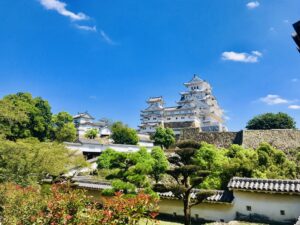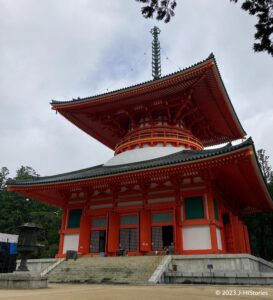The Golden Tea Room & Taian Tea Room
The walls, pillars, ceiling, and tea utensils covered in gold leaf reflect a solemn scarlet color in the Golden Tea Room through the scarlet woolen cloth on the Shoji screen. In contrast, Taian in Myokian Temple, a National Treasure, is the oldest existing tea room and one of three tea rooms of national treasures (Taian, Joan, and Mittan) in Japan. It has only about two tatami mats in size and is dimly lit, creating a wabi-sabi world of its own. The light filtering through a lattice window creates an atmosphere of ultimate beauty, stripped to the bare essentials, as favored by Rikyu. After a ten-year-long collaboration, why did Toyotomi Hideyoshi suddenly order Rikyu to perform Hara-Kiri (suicide by disembowelment)? There are several theories. One reason is said to be that both men were at the top of their worlds. Hideyoshi was the ruler of Japan. Rikyu was the head of the Tea World. Consequently, these two fall into incompatible conflicts. Let's take a closer look at their history.
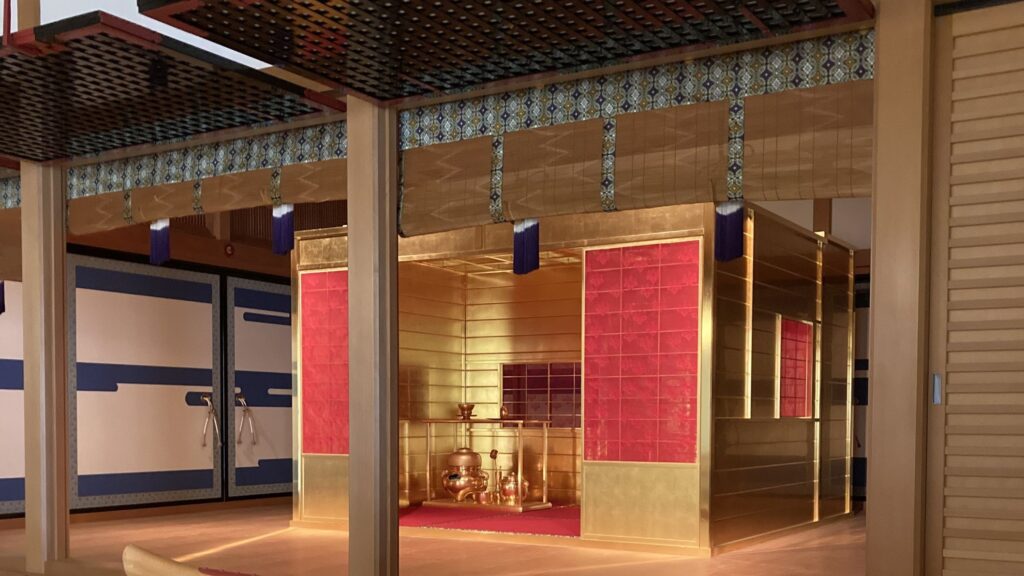
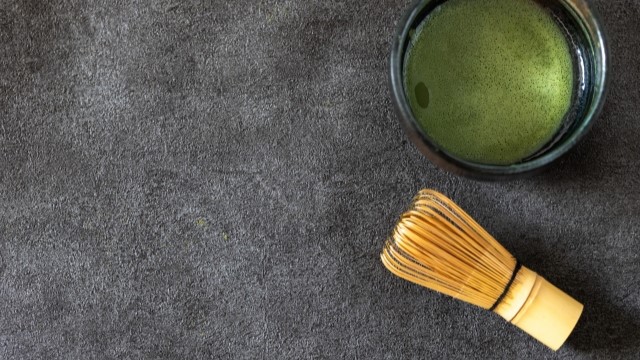
Sen-no-Rikyu, the Perfectionist of Wabicha (tea ceremony)

(@ Sakai City Museum)
Perhaps you have experienced or heard of the traditional tea ceremony. chanoyu (Way of Tea) was perfected by Sen-no-Rikyu (1522-1591, 千利休) during the 16th century. Rikyu’s unique style of chanoyu, known as Wabicha, aimed to simplify and remove unnecessary artificial elements to focus on the inherent spirituality of nature. To achieve this, Rikyu designed a very small and rustic tea house with only two tatami mats, featuring a crawl-in entrance to shift the guests’ mindset from their daily life to the tea world. Samurai were even required to leave their swords, as a symbol of their soul, outside. The tea utensils used were crafted from natural Japanese materials such as bamboo, and the tea bowls were solid black hand-molded by a potter named Cyojiro. This was a departure from the colorful and decorative Chinese tea bowls that were popular at that time.
The honeymoon between Hideyoshi and Rikyu
In the 15th century, tea ceremonies were held in large meeting rooms to showcase the many flamboyant fine arts and crafts imported from the Ming to guests. Tenkyokaku, a now non-existent building connected to Kinkakuji (Golden Pavilion), is a famous example of such a meeting place. It was built by the 3rd Shogun of Muromachi Shogunate, Ashikaga Yoshimitsu (1358-1408,足利義満). Several merchants in Sakai city in Osaka prefecture had a corner of these trades, which brought them enormous wealth. During the Warring States period (1467-1590), Oda Nobunaga (1534-1582, 織田信長), a new conqueror, utilized the trade skills of Sakai merchants and also the tea ceremony, where tea bowls were recognized as an ensign of his surrender. He assigned Imai Sokyu (1520-1591, 今井宗久) as a tea master to Sakai merchants with special privileges in the trades, including weapons and gunpowder. Alternatively, Sokyu was requested war funds.
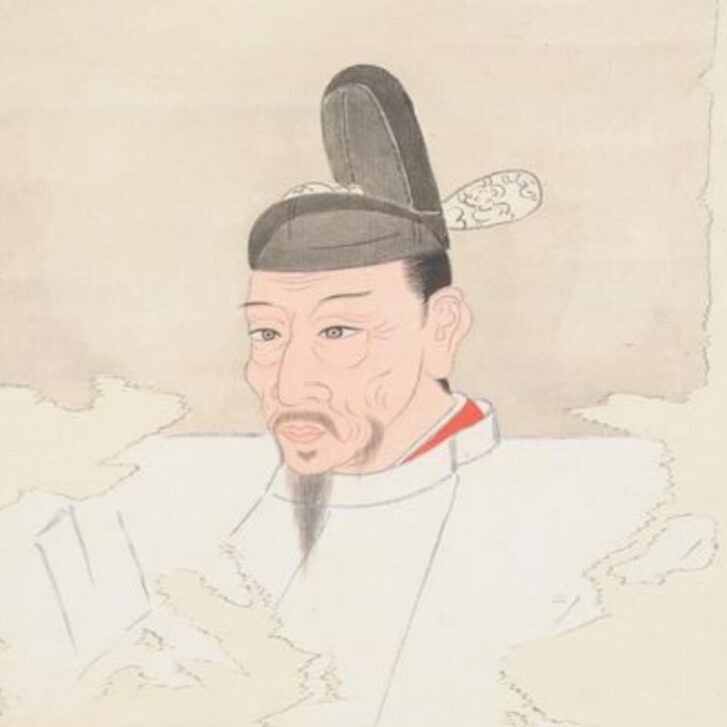
(@都城島津邸)
After Nobunaga’s sudden death in the Honnoji incident of 1582, one of his vassals, Toyotomi Hideyoshi (1537-1598, 豊臣秀吉), began to use the tea ceremony for administration purposes. At the age of 60, Rikyu became Hideyoshi’s tea master and served as his right-hand man politically as well. Hideyoshi often made political decisions in a small tea room served by Rikyu, while listening to Rikyu’s opinion. Rikyu expertly managed several tea ceremonies ordered by Hideyoshi, such as the Imperial Palace tea ceremony using the portable Golden Tea Room in 1586, and the Kitano tea ceremony at Kitano Tenmangu Shrine in 1587.
Conflicts between Hideyoshi and Rikyu
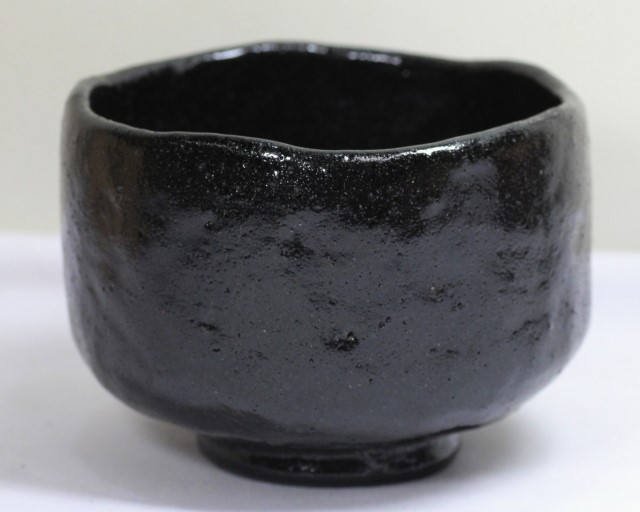
However, the situation between Hideyoshi and Rikyu changed after Hideyoshi’s victory in the final battle at the Odawara War in 1590, which led to the unification of the country against the Hojo clan. The state of their relationship worsened. Hideyoshi preferred grand and flamboyant styles, while Rikyu pursued his aesthetic of simplicity. Three symbolic episodes reflected this conflict. First, when Rikyu invited Hideyoshi to his tea ceremony, he cut all the bellflowers except for one. Hideyoshi saw just one morning glory in a small tea house. It is said that Hideyoshi began to feel some bitterness toward Rikyu. Secondly, at the New Year's tea ceremony in 1591, Rikyu used a black Raku bowl made by Chojiro because he believed that the green color of the tea in the black bowl was the perfect combination of wabi style. However, Hideyoshi disliked it. Lastly, at another tea ceremony, Hideyoshi put a wild chrysanthemum between a tea bowl and the Katatsuki (tea canister) to show off his self-confidence in his understanding of the wabi concept. Rikyu subtly removed it and proceeded with the tea ceremony as though nothing had happened. This impressed Rikyu’s greatness in the tea world, but it agitated Hideyoshi and probably triggered a deep-seated resentment of Rikyu.
Sticking to Their Ways of Life Brought On the Tragedy
In February of 1591, Hideyoshi ordered Rikyu to commit hara-kiri, though he intended to spare Rikyu if he bowed his head to Hideyoshi. However, Rikyu chose to commit ritual suicide at age 70. There are several theories proposed as to the reason for his hara-kiri. One reason is that Rikyu insisted on his wabi aesthetic, which he had developed throughout his life, and was unable to yield to Hideyoshi’s power. As a merchant from Sakai, Rikyu had a realistic nature to compromise and calculate. When he started serving Hideyoshi, he understood Hideyoshi’s idiosyncrasies and managed to balance his wabi tea way with Hideyoshi’s preferred way. However, after Hideyoshi unified the nation, Rikyu’s style was the only thing remaining unconquered by Hideyoshi. Another reason is that Hideyoshi no longer needed the tea ceremony or Rikyu after he was appointed Dajo-daijin (Grand Minister of State), which gave him the highest authority in Japan following the emperor. Until then, the tea ceremony was a tool to showcase his power and authority. Therefore, Hideyoshi likely wanted to conquer Rikyu and so ordered his hara-kiri. (by Tanaka Sendo, president of Dainihon Chado Gakkai, one of the schools of the tea ceremony). However, tea masters such as Furuta Oribe, Kobori Enshu, and Urakusai, who looked up to Rikyu as their teacher, continued to develop the chanoyu with their talents.
Two Tea Rooms, A Subtle and Profound Atmosphere
Please immerse yourself in the awe-inspiring ambiance of the Golden Tea House, envisioning its walls radiating an austere yet elegant scarlet hue, while soft natural light filters through the scarlet silk gauze of the sliding screen when closed, creating an atmosphere that is both subtle and profound. In contrast, the Taian Tea Room exudes an ineffably tranquil aura, with its delicate light seeping through the Shoji paper screen of the Renjiko-window. This tiny space only houses tea utensils, yet it conveys a boundless spiritual expanse. Ultimately, both rooms epitomize Rikyu's magic, drawing you into his world with ease.
Toyotomi Hideyoshi and Sen-no-Rikyu Timeline
| Toyotomi Hideyoshi | Sen Rikyu | |||
| 1336 | Ashikaga Takauji estabilished Muromachi Shogunate | - | Muromachi Period | |
| 1467 | Onin War started (- 1477) | - | ||
| 1522 | Sen Rikyu was born in Sakai | Age=1 | ||
| 1537 | Hideyoshi was born in Nagoya | Age=1 | ||
| 1573 | Muromachi Shogunate ended by the 15th Shogun, Yoshiaki was ousted by Nobunaga | 36 | Azuchi Momoyama Period | |
| 1574 | Rikyu joined Tea Party held by Oda Nobunaga | 52 | ||
| 1575 | Rikyu procured guns for Nobunaga | 53 | ||
| 1582 | Nobunaga was killed at Honnoji by Akechi Mitsuhide | 45 | ||
| 1582 | Hideyoshi defeated Akechi Mitsuhide | 45 | ||
| 1582 | Rikyu became a tea master of Hideyoshi | 60 | ||
| 1583 | Rikyu built Taian | 61 | ||
| 1584 | Rikyu built two tea rooms in Osaka Castle | 62 | ||
| 1586 | Hideyoshi held the tea ceremony for Emperor Ogimachi, bringing the Golden Tea Room | 49 | 64 | |
| 1587 | Hideyoshi built the huge Osaka castle | |||
| 1587 | Hideyoshi held Kitanotenmangu shrine tea ceremony | 50 | ||
| 1590 | Hideyoshi spearhead army to attack Hojo clan | 53 | ||
| 1590 | Hideyoshi unified the nation | 53 | ||
| 1591 | Rikyu Hara-Kiri | 54 | 70 | |
| 1598 | Hideyoshi passed away | 61 | ||
| 1600 | Tokugawa Ieyasu defeated Ishida Mitsunari, Hideyoshi's right arm at the battle of Sekigahara | |||
| 1603 | Ieyasu estabished Tokugawa Shogunate at Edo | Edo | ||
| 1615 | Toyotomi's Osaka Castle burnt down to the ground at the Summer Siege of Osaka | - |
Recommendations to visit
Golden Tea Room - MOA Museum
- Access: 40 minutes from Tokyo Station to Atami Station on JR Tokaido Shinkansen. 7 minutes by bus bound for MOA Museum of Art (final stop) at Bus Stop #8.
Golden Tea Room - Nagoya Castle Museum
- Access: 8-minute walk from JR Karatsu Station to Oteguchi Bus Center. Get a bus on Nomoto-Nagoya Line to Nagoya Castle Museum Bus stop for 35-min.
Taian Tea House in Myokian Temple
- Access: 15 min from Kyoto Station to Yamazaki Station on JR Tokaido Main Line. A one-minute walk to Myokian Temple.
- Need the reservation in advance by a return postcard.
Raku Museum
Access: 1 hour from Kyoto Station. Take bus #9 bound for "Nishigamo Shako (西賀茂車庫)" or #50 bound for "Kitano Tenmangu (北野天満宮), or Ritsumei kan University (立命館大学)” at A2 or D2. Got off at "Nakadachi-uri (堀川中立売下車)" bus stop, then a 3-minute walk.

